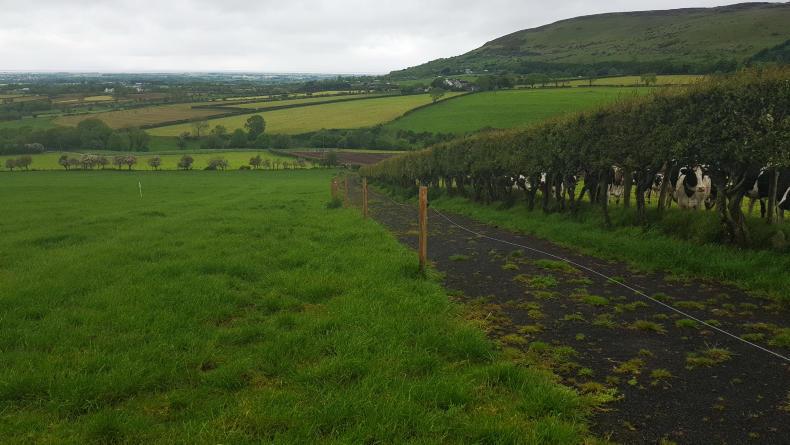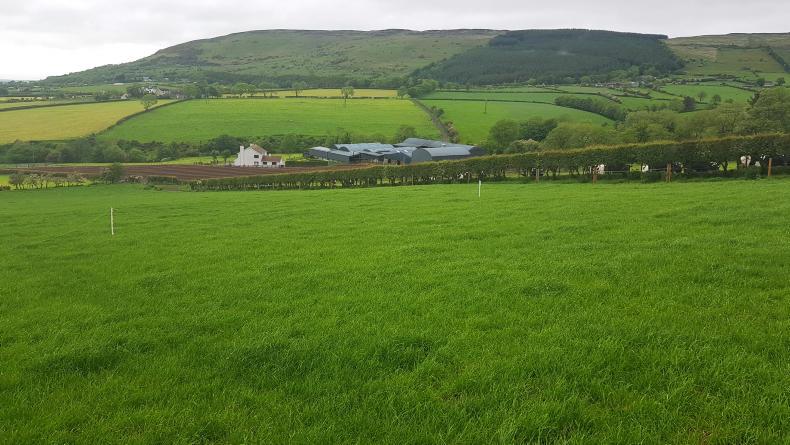Dairylink Ireland participants have been equipped with plate meters, set up with grass budgeting software and received on-farm advice about managing grass since they joined the programme last year.
Phase two programme farmers are now well versed in measuring grass covers and matching demand to supply. The benefits of better grassland management are now evident and will continue to be seen later in the season as an adequate amount of good-quality grass is available in paddocks.
Most farmers do not have access to the same help and guidance as participants on the Dairylink Ireland programme. So, for non-grass-measuring farmers who are considering taking steps to improve their grassland management, where do you start?
The following guidance is not scientific, but is a back-of-an-envelope approach to establish how much grass is on your farm and how much grass you need at present.

Cows are averaging 220 days in milk at present.
Firstly, make a list of all paddocks on the milking platform and write the size of each paddock in a column beside it.
The next step is to walk the milking platform to establish the available cover in each paddock.
Plate meters or the cut and weigh method are most accurate means, as they take sward density as well as height into account.
However, estimating covers based on sward height alone is better than nothing at all and it is a realistic starting point for non-measuring farmers.
The following figures and calculations are based on available cover, which is the system used in the Republic of Ireland.

Ground conditions have deteriorated slightly, but cows are still grazing without causing damage.
The system used mainly in Northern Ireland is based on total cover, which is simply available cover plus 1,500kg DM/ha.
To estimate covers based on height, a tightly grazed sward standing around 4cm from the ground has zero available cover. In general, every 1cm above this is around 250kg DM/ha.
The next step on the back of the envelope is to multiply the estimated available cover in each paddock by its size in hectares to get the available grass cover or the amount of feed in each paddock.
Add these figures up to get the available cover on the milking platform and then divide by the milking platform area to give average cover per hectare.
Weekly round-up
Walk the milking platform to establish average cover per hectare.Divide this by stocking rate to calculate average cover per cow.Mid-season target is to have a cover of 160kg to 180kg DM/cow.Make bales from surplus grass to increase stocking rate and lower average cover per cow.At the very least, walk paddocks that are due to be grazed within the next week.Keep cows on the best-quality grass by making bales from covers that are becoming too strong for grazing.Farmer focus: John Oliver, Limavady, Co Derry
The above steps outline how to calculate the supply side of a grass budget. There are several methods for matching this to demand. For example, Dairylink Ireland participants use computer software programmes such as AgriNet and PastureBase.
Dairylink farmer John Oliver had a problem connecting to the internet for a few days last week and had to make do with a quick back-of-an-envelope calculation after his grass walk. He found that average available cover on the milking platform stood at 695kg DM/ha.

A paddock beside the farmyard has been ploughed and limed ahead of reseeding once ground conditions improve.
John currently has three paddocks which are not included in these calculations. This includes two paddocks of surplus grass, which are being skipped over for bales, and one paddock that has been ploughed for reseeding.
His milking platform stocking rate sits at 3.4LU/ha, so average cover per cow is 204kg DM (average cover divided by stocking rate). The ideal cover per cow at present is between 160kg and 180kg DM/cow, so John has a slight surplus.
This means he should make bales from a few paddocks that are likely to be above the ideal pre-grazing cover of 1,300kg to 1,600kg DM/ha (approximately 9cm to 10.5cm in height) by the time cows are ready to graze them.
Skipping over these paddocks will push stocking rate up and will therefore bring average cover down closer to the mid-season target of 160kg to 180kg DM/cow.
Concentrates
John runs a block autumn-calving system, so most of the herd is in late lactation. Only cows yielding over 22 litres are receiving concentrates through in-parlour feeders at present.
Overall, the herd is currently averaging 20 litres at 3.78% fat and 3.51% protein. On average, cows are 220 days in milk and have yielded 6,300 litres from 2t of concentrates.
John is confident that he will get another 1,000 litres from the herd before drying off with minimal meal input.
Since soil-testing each paddock on the farm last winter, John has been proactive in addressing deficiencies in soil fertility. The main issue is soil pH, with the results showing that 70% of the farm is below pH 6.1.
Every acre that was found to be sub-optimal for pH has already received lime this season. A local contractor has been on the farm to spread lime after grazing at either 1t or 2t per acre.
John switched CAN for compound fertilisers (such as 20:10:10) for a round on some paddocks that had soils which analysed below optimal levels for phosphorus (P) and potassium (K).
Another application of compound fertiliser on some paddocks will be needed later in the summer.
With plenty of grass on the Oliver farm, there was a temptation to miss a round of nitrogen in some paddocks. However, Dairylink Ireland adviser Conail Keown said that doing this will reduce both the quality and quantity of grass later in the season.
Read more
Watch: addressing issues from soil analysis results
Dairylink: making silage four times a year
Dairylink Ireland participants have been equipped with plate meters, set up with grass budgeting software and received on-farm advice about managing grass since they joined the programme last year.
Phase two programme farmers are now well versed in measuring grass covers and matching demand to supply. The benefits of better grassland management are now evident and will continue to be seen later in the season as an adequate amount of good-quality grass is available in paddocks.
Most farmers do not have access to the same help and guidance as participants on the Dairylink Ireland programme. So, for non-grass-measuring farmers who are considering taking steps to improve their grassland management, where do you start?
The following guidance is not scientific, but is a back-of-an-envelope approach to establish how much grass is on your farm and how much grass you need at present.

Cows are averaging 220 days in milk at present.
Firstly, make a list of all paddocks on the milking platform and write the size of each paddock in a column beside it.
The next step is to walk the milking platform to establish the available cover in each paddock.
Plate meters or the cut and weigh method are most accurate means, as they take sward density as well as height into account.
However, estimating covers based on sward height alone is better than nothing at all and it is a realistic starting point for non-measuring farmers.
The following figures and calculations are based on available cover, which is the system used in the Republic of Ireland.

Ground conditions have deteriorated slightly, but cows are still grazing without causing damage.
The system used mainly in Northern Ireland is based on total cover, which is simply available cover plus 1,500kg DM/ha.
To estimate covers based on height, a tightly grazed sward standing around 4cm from the ground has zero available cover. In general, every 1cm above this is around 250kg DM/ha.
The next step on the back of the envelope is to multiply the estimated available cover in each paddock by its size in hectares to get the available grass cover or the amount of feed in each paddock.
Add these figures up to get the available cover on the milking platform and then divide by the milking platform area to give average cover per hectare.
Weekly round-up
Walk the milking platform to establish average cover per hectare.Divide this by stocking rate to calculate average cover per cow.Mid-season target is to have a cover of 160kg to 180kg DM/cow.Make bales from surplus grass to increase stocking rate and lower average cover per cow.At the very least, walk paddocks that are due to be grazed within the next week.Keep cows on the best-quality grass by making bales from covers that are becoming too strong for grazing.Farmer focus: John Oliver, Limavady, Co Derry
The above steps outline how to calculate the supply side of a grass budget. There are several methods for matching this to demand. For example, Dairylink Ireland participants use computer software programmes such as AgriNet and PastureBase.
Dairylink farmer John Oliver had a problem connecting to the internet for a few days last week and had to make do with a quick back-of-an-envelope calculation after his grass walk. He found that average available cover on the milking platform stood at 695kg DM/ha.

A paddock beside the farmyard has been ploughed and limed ahead of reseeding once ground conditions improve.
John currently has three paddocks which are not included in these calculations. This includes two paddocks of surplus grass, which are being skipped over for bales, and one paddock that has been ploughed for reseeding.
His milking platform stocking rate sits at 3.4LU/ha, so average cover per cow is 204kg DM (average cover divided by stocking rate). The ideal cover per cow at present is between 160kg and 180kg DM/cow, so John has a slight surplus.
This means he should make bales from a few paddocks that are likely to be above the ideal pre-grazing cover of 1,300kg to 1,600kg DM/ha (approximately 9cm to 10.5cm in height) by the time cows are ready to graze them.
Skipping over these paddocks will push stocking rate up and will therefore bring average cover down closer to the mid-season target of 160kg to 180kg DM/cow.
Concentrates
John runs a block autumn-calving system, so most of the herd is in late lactation. Only cows yielding over 22 litres are receiving concentrates through in-parlour feeders at present.
Overall, the herd is currently averaging 20 litres at 3.78% fat and 3.51% protein. On average, cows are 220 days in milk and have yielded 6,300 litres from 2t of concentrates.
John is confident that he will get another 1,000 litres from the herd before drying off with minimal meal input.
Since soil-testing each paddock on the farm last winter, John has been proactive in addressing deficiencies in soil fertility. The main issue is soil pH, with the results showing that 70% of the farm is below pH 6.1.
Every acre that was found to be sub-optimal for pH has already received lime this season. A local contractor has been on the farm to spread lime after grazing at either 1t or 2t per acre.
John switched CAN for compound fertilisers (such as 20:10:10) for a round on some paddocks that had soils which analysed below optimal levels for phosphorus (P) and potassium (K).
Another application of compound fertiliser on some paddocks will be needed later in the summer.
With plenty of grass on the Oliver farm, there was a temptation to miss a round of nitrogen in some paddocks. However, Dairylink Ireland adviser Conail Keown said that doing this will reduce both the quality and quantity of grass later in the season.
Read more
Watch: addressing issues from soil analysis results
Dairylink: making silage four times a year









 This is a subscriber-only article
This is a subscriber-only article










SHARING OPTIONS: